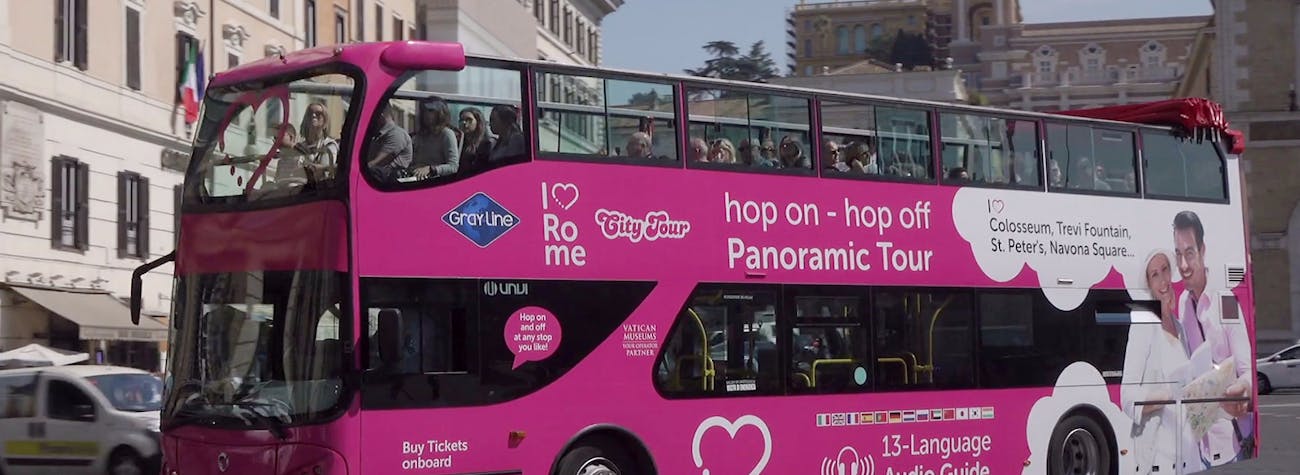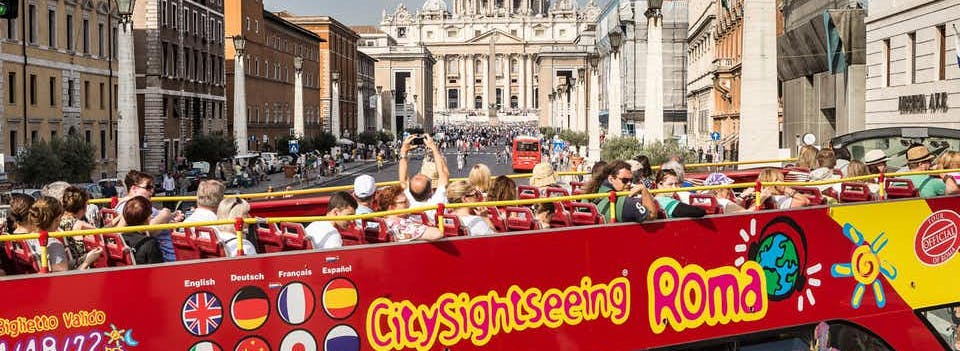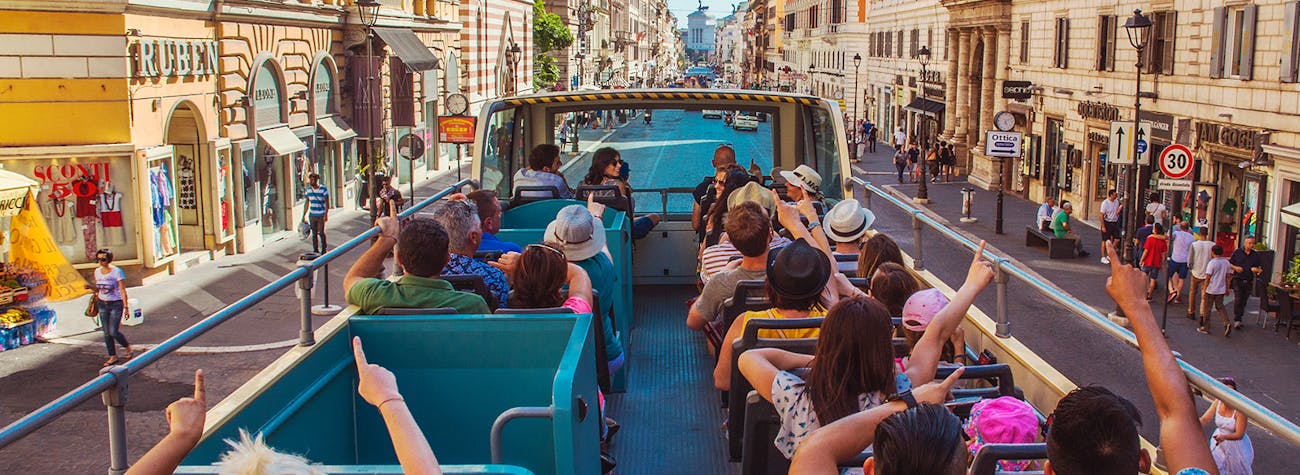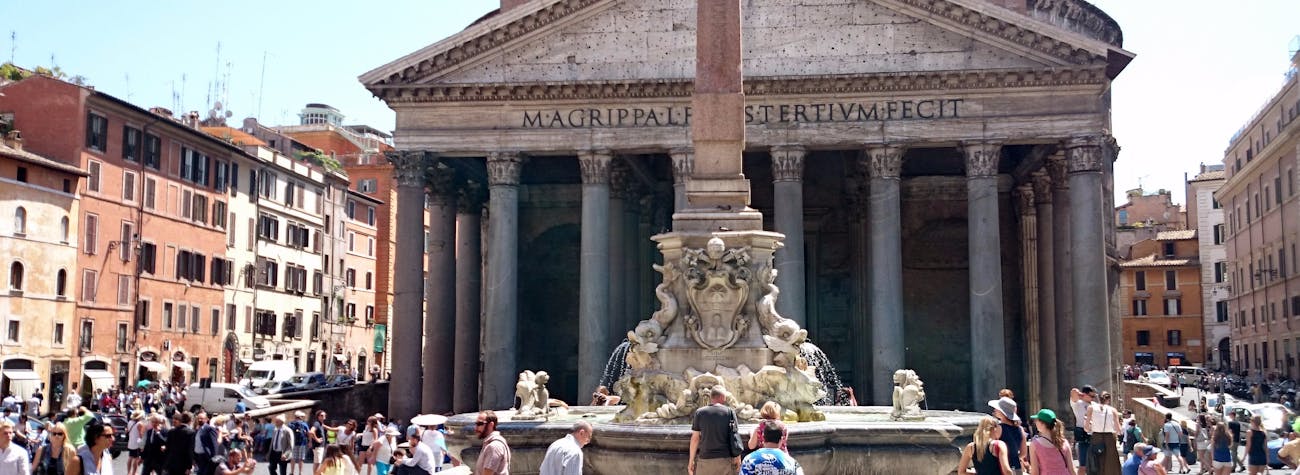The ancient seat of the progenitors of Western Civilisation, Rome is a classic European city that is a mix of historic ruins, stunning works of art & architecture, great food and a vibrant city life making it one of the most beautiful and romantic cities in the world.
Rome has an immensely rich cultural heritage, which makes it one of Europe’s most stunning cities to visit. Its contemporary fashion offerings and modern nightlife, coupled with its historic legacy make it attractive for travellers of all ages and interest groups. If you’re a nature lover, Rome’s beautiful gardens and the nature are a treat for the eyes. Loved Gladiator? You can act the part by enrolling in Gladiator school. Love the food? Rome’s multitude of Italian cooking classes offer a chance to interact with the locals and make some lasting memories. Are you a movie buff? Recreate Roman Holiday on a vespa at night. And if you’ve got the stomach for it, visit the Roman catacombs and see 4,000 bones of Capuchin monks.
Indeed, Rome has an experience for every traveller, making it a truly global city.
Why Rome?
A rich history, cobble stoned paths, stunning architecture, centuries-old palaces – Rome has it all.
One of Europe’s most historical cities, Rome balances its past with its present, as the historic ruins stand in the heart of this sprawling contemporary city. Its strong cultural offerings make it a must-visit destination! The ancient ruins will take you back in time. Home to the Pope, you can also visit the center of Catholicism at the Vatican and marvel at the grand architecture. No trip to Rome is complete without admiring the treasure trove of art in the museums across the city. Rome’s modern orchestra building and the variety of philharmonic performances are a must watch. And, of course, you can learn all about the mighty Roman Empire which once controlled most of southern Europe and northern Africa.
The Romans really know how to party and have a good time - the rising number of nightclubs is a testament to that fact. If you’re not into clubbing, many of Rome’s trendy bars serve aperitivo, or the Italian version of Happy Hour, for you to relax and unwind. The rise in upscale restaurants that serve food from all around the world points to the changing tastes of the Romans, and its rise as a global city.
Speaking of food, Rome’s strong and distinctive style of cooking sets it apart from the rest of Italian cuisine. The Romans liked to push boundaries when it came to their food, and it shows in their bold use of ingredients. Rome’s pizza al taglio, or pizza by the slice, their suppli (fried rice ball with mozzarella), and the spaghetti carbonara are some must-try delicacies. And if you’ve got a sweet tooth, Roman croissants and breads, especially the crostata ricotta and torta ricotta with cherries, are absolutely scrumptious.
Top 10 things to do in Rome
Just the word ‘Rome’ conjures images of the magnificent Colosseum, cobbled streets, opulent monuments, majestic churches, and fascinating historic ruins. Within it is also the one of the holiest cities in the world - Vatican City, which is the home of the Pope, and an utter delight to explore. A traveller’s paradise, the city has something for everyone, be it art, history, culture, food, or nightlife.
In this guide, we will take a look at the 10 best things do in Rome — whether you're looking at museums, churches, or even monuments from Ancient Rome, you will find them in this list. However, if you want to take a deeper look into the different activities, then click on the markers above to go to that list.
Rome essentials
Rome trip planner
All you need before you book your tickets and zip your bag!
Weather in Rome
Rome is an eternal vision throughout the year, with every season adding its own special charm into the mix. Here’s what you can expect from the city during the four seasons. You can check the weather here.

Rome in spring
Rome is simply enchanting during spring. The blossoming flowers, especially the pink azaleas strewn over spanish steps, the spring sun that enlightens the city’s landmark like a beautiful painting, the slight snip in the air that makes activities like walking tours and bike rides a leisure and the festivities of Easter and Rome’s birthday that calls out to tourists and locals alike. Here is the detailied guide to visit Rome in summer

Rome in summer
Summer is the peak season for Rome, it’s hot, it’s crowded and it’s buzzing with activities. With around 10 to 11 hours of sunshine per day and almost no rainfall, the summer months see plenty of open-air events and concerts organised around the city such as the Festa di San Giovanni. Just make sure to pack sunglasses, sunblock and stay hydrated.

Rome in autumn
As the soaring heat give way to cooler temperature, Rome welcomes the season with multiple cultural events celebrating the art, music, theatre, food of the country, such as the Romaeuropa Festival and the International Film Festival of Rome. The comfortable temperature in Autumn along with the changing colors of the surrounding, makes the season best for pleasant strolls.

Rome in winter
The winter winds do not slow down the pace of Rome. Though the flocks of tourists arriving does slow down, the ones braving the cold, in turn, earns great travel bargains and greater sightseeing experiences. Several festive markets are strewn across the city and just after Christmas, massive discounts are announced by almost every retailer, making winter the best time for shopping as well. Here is the detailied guide to visit Rome in winter
Detailed Rome itineraries
Take a look at these meticulously crafted Rome itineraries that have been designed to help you make the most of your stay in Rome - taking in all that makes Rome the vibrant city that it is and not missing out on the classical aspects of the city that define its fabric.
How to save money in Rome?
Rome, like all other tourist cities, can get expensive, given that there is a variety of options. Here are our top five hacks to save money, so that you can enjoy Rome even on a tight budget.
1. Buy a City Pass
The Roma Pass is an all-inclusive city pass available for 48 hour or 72 hour durations. The 48 hour pass includes free entry to one attraction per pass (out of 50) and the 72 hour pass includes free entry to two attractions per pass. The pass knocks off €2 from the entry fee to other attractions, and includes unlimited metro, bus, and tram travel.
The OMNIA pass has all the benefits of a Roma Pass, and in addition, includes entry to the Vatican Museums, St Peter’s Basilica, and a Hop on Hop off Tour of Rome. This pass can be purchased for €108.
The best way to enjoy these passes is to visit maximum attractions in a set time frame of your choosing, and visit the most expensive destinations for free.
2. Use public transport
Rome’s ATAC bus and metro service costs €1.50 flat per trip. The tickets are valid for 100 minutes from when they are stamped. If you have more than five journeys to undertake in a day, you are better off getting the 24 hour pass at €7 per day. If you’re in the city for longer, the 48 hour pass costs €12.50, the 3 day pass costs €18, and a week’s pass costs €24. These tickets are sold at newspaper stands and metro stations. Look out for the bright blue T signs, which show the counter selling tickets. You can also download the ProBus app for information on nearest bus and metro stations.
3. Enjoy an Italian Aperitivo for dinner
One of the peculiarities of Italian culture is enjoying a drink before dinner. The Italians believe this helps them get warmed up. Most places offer light snacks with drinks, but some bars offer a full-fledged buffet, where it is perfectly acceptable to refill your plate several times. Aperitivo mostly runs between 7 PM to 9 PM. Most places offer pizza, canapés, cheese, salad, and desserts. The top spots in Rome for Aperitivo are Freni e Frizione, Momart Café, and Rec23.
4. Take advantage of free sights and free days
There are many sights in Rome, which are completely free for tourists to enjoy:
• Toss a coin at Trevi Fountain. Legend says you will return to Rome if you flip one.
• Head over to the Spanish Steps. Relaxing at the steps is free.
• Discover Rome on foot. Most spots are well connected and are perfect for a relaxed amble.
• Enjoy free concerts between June and September. Check out Estate Romana, a citywide programme of open air concerts, cinema, dance and theatre.
There are “free days” in a month, where a host of Roman museums and sights are free to visit. Most state-owned museums like Borghese Gallery and the Colosseum are free on the first Sunday of the month. The Vatican Museums are free on the last Sunday of every month. However, you will have to beware of long queues.
5. Visit during off-season
Rome gets very crowded during the peak season, which is mid-June to September. Expect heavy tourist crowd and long queues during this time. April to mid-June and September through October are shoulder seasons, which see lesser tourists. November through March, the Roman winter, is off-season. Travelling during shoulder and off-season will guarantee cheaper airfare and discounts at hotels.
Day trips from Rome
Italy’s glorious capital, Rome is one of the world’s most romantic, spectacular and awe-inspiring cities. Rome and the surrounding regions of Italy are an amalgamation of artistic heritage & culture, ancient ruins, breathtaking landscapes, vibrant picturesque streets, cheerful bars and cafes and many more hidden treasures. Not only is there so much to see in Rome, but it is also blessed to have so many wonderful locations close by that can be easily visited when you visit Rome. Within a few hours reach, these destinations are best covered through day trips from Rome. These trips are very popular, convenient and practical as save you a lot of hassle of check-in/ check-out, packing/unpacking, time and money.
Here is everything you need to know about day Trips from Rome.
Public transportation in Rome

Rome is a big city. Unlike other great tourist cities in Europe where attractions are usually concentrated in the city center, or in surrounding neighborhoods; the landmarks of Rome are spread out throughout the city. If you wish to see everything that Rome has to offer, or visiting landmarks which you know are spread about, then the Roman public transportation system is definitely the friend you need. Here's a quick guide on all you need to know about public transportation in Rome.
Rome Hop On Hop Off Bus Tours

‘Rome’, the world’s most beautiful ancient city is a treasure of history, architecture, art and culture. No wonder it captivates the hearts of millions of tourists every year. The haunting ruins of the rich heritage of Rome come alive in the spectacular architecture of its palaces, churches, temples, and villas. The awe-inspiring art and countless pieces of rare artefacts adorn the museums. Brimming with life and romance the vibrant streets of Rome are a paradise for lovers. Painstakingly manicured gardens, buzzing piazzas, spirited theatres, Renaissance art, shopping - there is so much to experience and enjoy in Rome. You can spend any amount of time to discover and absorb what this majestic city offers. One of the best ways to explore the city is through the Rome Hop On Hop Off bus tours.
Read more about Hop On Hop Off Bus Tours.
Big Bus Rome Tours

Rome, the charming capital of Italy, is a sprawling city studded with numerous historical landmarks and attractions. Renowned world over for its ruins, renaissance architecture, museums full of artistic treasures, grand basilicas, romantic street-side cafes and piazzas, Rome has simply too much to offer to a traveller! Exploring a city like Rome can easily get overwhelming for a first-time visitor. The most convenient way to explore this beautiful city is with Big Bus Rome. The comfortable open-top double decker buses will give you the true flavour of Rome with the flexibility of planning your own itinerary. Let's dive right into our Big Bus Rome guide and help you find the perfect Rome hop-on-hop-off tour.
Read more about Big Bus Rome Tours.
Rome sightseeing tours

Rome is an overwhelmingly beautiful city, with lots to offer. What was once the greatest civilizations in the Western world, today is the perfect example of a city that is contemporary, but has not forgotten its roots. To truly experience Rome and the Roman way of life, it is advised that one should go on a sightseeing tour. These are carefully curated to show you some of the best parts of city, especially if you're pressed for time.
There is a tour for everyone - if you love food, you can try out the Food Tours and Cooking Classes; if you're interested in seeing the city in its entirety, there's City Tours. If you want to explore the beautiful neighbouring regions in Italy, like Venice, Pomepii, or Florence, Day Trips are for you. Here, you can find some of the best tours in Rome:
Here is the complete guide of Rome sightseeing tours.
Getting around in Rome
Rome can be explored by car, however, local traffic is almost unmanageable for tourists. It is better to travel in a bus or by the metro.
Taxis are the most expensive way to get around Rome. Most taxis can be picked up at taxi stands. A fixed charge of €1 will be charged per bag that is handled by the driver. It is recommended to use the map while travelling in the taxi to ensure you’re on the right road.
Most of the popular tourist areas in Rome are easily navigable by road. It is however, advisable to be cautious while crossing. Even though traffic may be intimidating, most cars allow people to cross the road.
The most popular forms of public transport are buses, metros, and trams. Tickets for these have to be purchased before alighting the form of transport. Tickets are sold either for every journey or there are passes for a particular period of time, like for example, there are 24 hour, 48 hour and 72 hour passes. There is also a weekly ticket. Buses are the best form of travelling in the city. There are 3 tram lines operating in the city. The metro is the most reliable form of transport. It is usually on time, but is crowded during rush hour.
Hotels in Rome
Rome is a very popular city and there is no shortage of accommodation options. There is a range for every traveller. The lowest starts from €20 and goes up to €5,500 for an apartment in the Vatican. Waldorf Astoria, one of the top luxury chains has rooms for around €1,000.
Rome has a variety of hotels, from budget to luxury. Hotels in the downtown area get expensive but provide convenience, since most tourist attractions are close by. Apartments are a very popular alternative to hotels, especially on popular websites such as Airbnb. For the budget traveller, there are a host of hostels. Most of the hostels are clean and well managed. If you’re looking for privacy, most hostels also have private rooms.
Hotels on the eastern and southern side of the railway station are usually cheaper. These hotels are further away from the downtown area but offer some great deals.
Festivals in Rome
Rome has a year long calendar of festivals - some cultural, some religious, some patriotic, a few music festivals and so on. Here are the top recurring festivals that you should know of:
- Lungo il Tevere - Estate: June
- Festival del Verde e del Paesaggio: May
- Cortili Aperti: May
- Taste of Roma: September
- Ides of March: March
- Festa Del Cinema di Roma: October
- Christmas: December
- VinòForum: June
- Festa Madonna della Neve: August
- Città della Pizza: April
- Festa de' Noantri: July
- Festa della Befana: January
- Festa della Befana: January
Rome culture tips
• Romans regularly interact with foreigners and are generally polite and friendly. One common term to use is mi scusi or simply scusi, which means sorry, if you want to approach anyone.
• It is customary to vacate your seat in public transport for the elderly. Most of Rome is a Catholic population. Most of the older generation speaks Italian. The younger generation also speaks English. Rome is a popular city and there is a lot of information to help tourists if need be. Spanish, French and Portuguese are also understood, however, locals do not take kindly to be addressed in Spanish instead of Italian.
• In a restaurant, you will be charged for bread, so wave it off if you do not want it. It is prudent to check the bill for items ordered and charges. Most restaurants do not serve free water. It is charged separately.
• It is also not customary to order coffee after 11 AM. Italians order coffee to finish off the meal, and very rarely order it during the day. Espresso is usually ordered after meals and not a cappuccino, which the locals consider a heavy drink. Locals also do not order antipasti, primi, secondi, insalata, and dolce. You can simply order whatever you like from the menu in whatever order.
Tipping
Tipping is not expected in Rome. Most restaurants include service charge or tips which directly goes to the staff. However, it is standard to add an extra euro or two in case of good service.
Check your bill carefully for these two charges - coperto and servizio. Coperto is always illegal in the Lazio area and servizio is illegal unless it has been mentioned in the menu.
FAQs
The most popular tourist attractions in Rome include the Colosseum, the Vatican Museums, St. Peter's Basilica, and the Trevi Fountain.
Some of the best restaurants in Rome include La Pergola, Da Emilio e Franco, and Antica Pesa.
Some of the best hotels in Rome include the Hassler Roma, the Grand Hotel de la Minerve, and the Hotel Eden.
Some of the best shopping opportunities in Rome include the Via Condotti, the Piazza di Spagna, and the Via del Corso.
Some of the best nightlife options in Rome include the bars and clubs in the Trastevere district, the live music venues in the Campo de' Fiori area, and the dance clubs in the Testaccio district.
Some things to avoid in Rome include pickpockets, overpriced tourist traps, and getting ripped off by taxi drivers.
You could easily spend a week or more in Rome and still not see everything the city has to offer. However, if you're only visiting for a few days, you'll need to make some tough choices about what to see and do. Depending on how long you are there, you can make your decision on what to see using our curated Rome Trip Planner.
The best way to get around Rome is on foot. However, if you're travelling with luggage or plan to visit some of the outlying areas, you may want to take advantage of the city's public transportation system, which includes buses, trams, and metro trains. You can read our guide on Public Transportation in Rome for more details.
All Rome guides


















